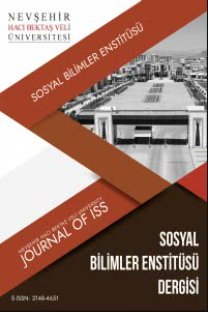YAPAY ZEKÂ TABANLI SİSTEMLERDEN ÜRETİLEN TEKNOLOJİLERİN ASKERİ HAREKÂTIN SEVK VE İDARESİNDE KULLANILMASINA YÖNELİK BİR DEĞERLENDİRME
Yapay Zekâ, Simülasyon Sistemleri, Askeri Harekât., Askeri Karar Verme Sistemleri
___
- Atkin, M.S. (2003). Revolutionizing Science and Engineering Through Cyberinfrastructure: Report of the National Science Foundation Blue-Ribbon Advisory Panel on Cyberinfrastructure.pp.3
- Babak, T.R., Farzad, K. L.J. Luotsinen, L.J. and Gisslén, L. (2017). Evaluating Deep Reinforcement Learning for Computer Generated Forces in Ground Combat Simulation. IEEE International Conference on Systems, Man, and Cybernetics (SMC). Banff, AB, 2017, pp. 3433-3438, http://doi.org:10.1109/SMC.2017.8123161.
- Bentahar, J. (2010). A taxonomy of argumentation models used for knowledge representation. Artificial Intelligence Review 33(3). pp.211–259. http://doi.org:10.1007/s10462-010-9154-1
- Bohman, W.E and Staffsim, J. (1999). An Interactive Simulation for Rapid, Real Time Course of Action Analysis by U.S. Army Brigade Staffs, Monterey, CA.pp.36-42
- Brehmer, B. (2010). Command and control as design. In Proceedings of the 15th International Command and Control Research and Technology Symposium. Washington, DC: US Department of Defense CCRP, pp.182.
- Brynielsson, J. (2007). Using AI and games for decision support in command and control. Decision Support Systems 43(4):1454–1463. http://doi.org:10.1016/j.2006.06.012
- Brynielsson, J. (2009). Development of computerized support tools for intelligence work. In Proceedings of the 14th International Command and Control Research and Technology Symposium. Washington, DC: US Department of Defense CCRP, pp.48.
- Brynielsson, J. (2014). Cyber situational awareness – A systematic review of the literatüre. Computers & Security, Volume 46, pp.18-31. http://doi.org:10.1016/j.cose.2014.06.008
- Guerlain, S., Brown, D.E. and Mastrangelo, C. (2010). Smc 2000 conference proceedings. 2000 ieee international conference on systems, man and cybernetics. 'cybernetics evolving to systems, humans, organizations, and their complex interactions' (cat. no.0, Nashville, TN, 2000, pp. 1934-1938 vol.3, http://doi.org:10.1109/ICSMC.2000.886396.
- Hayes, C.C. and J.L. Schlabach (2002). FOX-GA: A Planning Support Tool for assisting Military Planners in a Dynamic and Uncertain Environment, AAAI Press.pp.24-32
- Jandel, M.(2016). Decision support for releasing anonymised data. Computers & Security, Volume 46, pp.48-61. http://doi.org:10.1016/j.cose.2014.07.001
- Johnson, J. (2019). Artificial intelligence & future warfare: implications for international security. Defence nd Security Analysis, Volume 35, İsuue 2. pp.147-169. http://doi.org::10.1080/14751798.2019.1600800
- Kewley, R. and Embrecht, M. (2002). Computational military tactical planning system. IEEE Transactions on Systems, Man, and Cybernetics, Part C (Applications and Reviews. pp.161-171.
- Klein, Etienne (2014). Dünyayı Değiştiren Fizik Devrimi, Say Yayınları, İstanbul.
- Lei, L., Tan,Y., Zheng, K., Liu,S., Zhang, K. and Shen, X. (2020). "Deep Reinforcement Learning for Autonomous Internet of Things: Model, Applications and Challenges," in IEEE Communications Surveys & Tutorials, vol. 22, no. 3, pp. 1722-1760. http://doi.org:10.1109/COMST.2020.2988367.
- Lent, M., Fisher, W. and Mancuso, M. (2004). An explainable artificial intelligence system for small-unit tactical behavior. Proceedings of the 16th conference on Innovative applications of artifical intelligence, pp. 900– 907.
- Marr, J. (2001). The Military Decision Making Process: Making Better Decisions Versus Making Decision Better, Fort Leavenworth, KS. pp.12
- Moradi, F. and Schubert, J. (2014). Simulation-based defense planning In Proceedings of the NATO Symposium on Integrating Modelling & Simulation in the Defence Acquisition Lifecycle and Military Training Curriculum (MSG-126), Washington, DC, USA, pp. 1−16.
- Paparone, C.R. (2001). US Army Decision-making: Past, Present and Future, Military Review. US Army CGSC, pp.45.
- Prelipcean, G. and Boscoianu M. (2008). Computational framework for assessing decisions in energy investments based on a mix between real options analysis and artificial neural networks, in Proceedings of the 9th WSEAS International Conference on Mathematics & Computers in Business and Economics (MCBE’80), pp. 179-184
- Prelipcean, G. and Moisescu, F. (2011). Efficient Decision Support Systems-Practice and Challenges in Multidisciplinary Domains. IntechOpen. p. 359-376
- Rogers, E. (2010).Diffusion of Innovations. Free Press. University of Michigan, USA. pp.234
- Schubert, J., Brynielsson, J., Nilsson, M. and Svenmarck, P. (2018). Artificial intelligence for decision support in command and control systems in Proceedings of the 23rd International Command and Control Research & Technology Symposium, Pensacola. Washington, DC, 2018, pp.30.
- Silver, D., Schrittwieser, J., Simonyan, K., Antonoglou, I., Huang, A., Guez, A., Hubert, T., Baker, L., Lai, M., Bolton, A., Chen, Y., Lillicrap, T., Hui, F., Sifre, L., van den Driessche, G., Graepel, T. and Hassabis, D. (2017). Mastering the game of Go without human knowledge. Nature 550:354–359. http://doi.org:10.1038/nature24270
- Svenmarck, P., Luotsinen, L., Nilsson, M. and Schubert, J. (2018). Possibilities and challenges for artificial intelligence in military applications In Proceedings of the NATO Big Data and Artificial Intelligence for Military Decision Making Specialists' Meeting (IST-160), Bordeaux, France, NATO Research and Technology Organisation, pp. 1−16.
- Şengöz, M. (2019a) Yönetim Felsefesi: Gazi Paşa’nın Perspektifinden Aksiyolojik Liderlik Üzerine Mülahazalar. Ankara: Astana Yayınları.s.65-73
- Şengöz, M. (2019b). Leadership Challenges in the Current Security Environment, Ankara: Astana Yayınları.s.11.
- Şengöz, M. (2020). The Framework of Military Leadership, Cambridge Scholars Publishing.pp.9-15
- Turner, P. and Dodd, L. (2016). Developing the cognitive and social aspects of military ‘understanding capability’. In Proceedings of the 21st International Command and Control Research Technology Symposium. Washington, DC: International Command and Control Institute, pp. 69.
- Yayın Aralığı: 4
- Başlangıç: 2011
- Yayıncı: Nevşehir Hacı Bektaş Veli Üniversitesi
REFİK HALİD KARAY’IN SİYASİ KİMLİĞİ IŞIĞINDA “DELİ” ADLI TİYATRO ESERİ
NEVŞEHİR’DE GÜNÜMÜZE ULAŞAMAYAN BİR OSMANLI YAPISI: TAHTALI KAHVEHANE
COVID 19 SALGINININ BUTİK OTEL İŞGÖRENLERİ ÜZERİNDEKİ ETKİSİ: GÖREME ÖRNEĞİ
Sevgi EROĞLU GÜMÜŞ, Burcu Gülsevil BELBER
TÜRK ATASÖZLERINDE SOY VE AKRABALIK
SOSYAL BİLGİLER ÖĞRETİMİNDE ÇÖZÜMLEMELİ ÖYKÜNÜN KULLANIMINA YÖNELİK ÖĞRETMEN ADAYLARININ GÖRÜŞLERİ
Selahattin KAYMAKCI, Tuğba TURGUT, M. Talha ÖZALP
ZİHİNSEL YETERSİZLİĞİ OLAN ÖĞRENCİLERE FEN EĞİTİMİ: YÖNTEM VE STRATEJİLER
Tansel YAZICIOĞLU, Aydın KIZILASLAN
Kibar SUNGUR GÜL, Huseyin ATES
Eda Elif ANNAKKAYA, Gülsün BASKAN
MACRO ECONOMIC EFFECTS OF THE EUROPEAN CENTRAL BANK'S ASSET PURCHASE PROGRAMS
